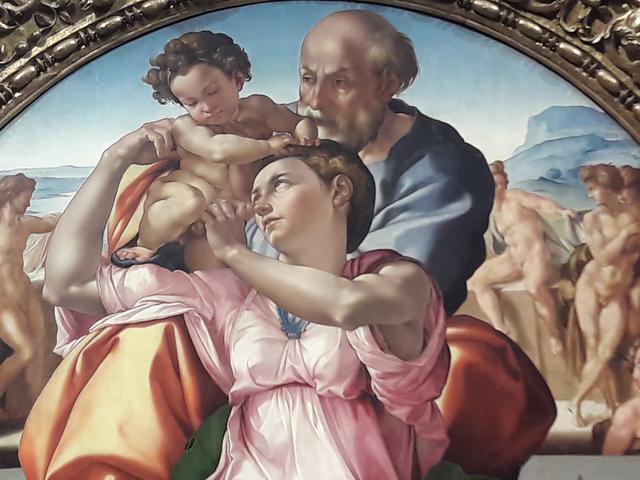Round gifts

Michelangelo painted this Holy Family for a Florentine merchant, Agnolo Doni, whose prestigious marriage to Maddalena Strozzi in 1504 took place in a period that was crucial for Florentine art of the early 16th century. The presence in the city of Leonardo, Michelangelo and Raphael together boosted the already lively Florentine art scene, which in the first decade of the century experienced a period of great cultural fervor. Agnolo was thus able to celebrate his marriage and the birth of his first child with some of the highest expressions of this exceptional artistic period: a portrait of husband and wife painted by Raphael and Michelangelo's 'tondo', which is the only completed panel . Artist painting to survive. Michelangelo had not long studied the potential of the circular form, which was highly prized in the early Renaissance for religious home decorations, in the marble of the "Pitti Tondo" (National Bargello Museum) and the "Taddei Tondo " (Royal Academy). of London): in both cases, the Virgin, the child and the infant Saint John powerfully occupy the entire surface of the relief. The "Doni Tondo" is also conceived as if it were a sculpture, in which the pyramidal composition of the group occupies almost the entire height and width of the panel. It has been observed that the compactness of the group is like the structure of a dome, although it is animated inside by the twisted bodies and the concatenation of gestures when the Child Jesus gently passes from the hands of Saint Joseph to those of Mary. This composition, so articulate and expressive, comes from Michelangelo's own knowledge and study of the great marble sculptures of the Hellenic period (3rd-1st centuries BC), with their extraordinary spiral movements and high degree of expression, which emerged from the excavations. of Roman villas. Some of these important finds, such as the Apollo from the Belvedere and the Laocoön excavated in January 1506, are quickly mentioned in the painting, among the naked figures leaning against a balustrade (to the left and right of Saint Joseph). Laocoön's presence made it possible to date the tondo to a period that coincided with the birth of Maria Doni (September 1507). The naked youths, whose identification is complex, seem to represent pagan humanity, separated from the Holy Family by a short wall representing original sin, beyond which there is also an infant Saint John, who seems to refer to the interpretation of the paint. like for a baptism.
The frame around the painting, probably designed by Michelangelo, was carved by Francesco del Tasso, an exponent of the highest level of the wood carving tradition in Florence. It shows the head of Christ and those of four prophets, surrounded by grotesques and clusters, in which there are crescents, hidden in the upper left: the emblem of the Strozzi family.
© Tourblink